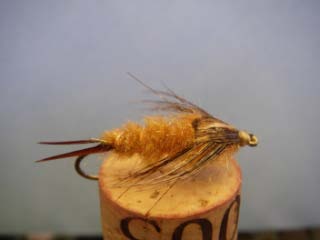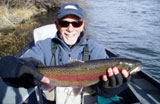|

Bill's Simple Stonefly Nymph
|
Materials:
|
|
Hook:
|
Tiemco 200R; Daiichi 1260, sizes 4-12 |
|
Bead:
|
Black or gold |
|
Thread:
|
Black, or to match |
|
Weight:
|
Lead at thorax |
|
Tail:
|
Biots |
|
Abdomen:
|
Black, or other color |
|
"Rib:"
|
V-rib or Larva Lace, color to match |
|
Wingcase:
|
Turkey or synthetic such as swiss straw, or bugskin |
|
Hackle:
|
Black hen, or other color |
|
Legs:
|
Ditto; alternative-rubber leg material to match |
|
Thorax:
|
Black, or other color |
|
Antennae:
|
Biots |
|
Head:
|
Thread |
|
|
Description
Stoneflies are found on virtually all freestone streams. They like relatively fast-moving, oxygenated water. Their lifecycle is described in the entomology discussion on this site (Link needed here). Briefly, they live 1-2 years on the bottom as nymphs, then generally crawl to shore or to riparian vegetation to hatch. It is during this migration that they are most vulnerable, although they do get into the drift at times. Trout feed on them whenever and however they are available.
This pattern is by no means founded on original thought on my part. Rather, like many patterns, it is an adaptation of time-tested tying techniques and materials. I am a fan of simple, easy to tie patterns that utilize readily available materials. This pattern certainly fills that bill. The instructions are for a black fly; if, for example, you need to tie Golden Stonefly imitations, simply change the dubbing, ribbing, and other materials to fit your needs. Nothing changes in the tying progression or in the techniques used. The same principal applies to size-i.e., there are very large stoneflies such as the Pteronarcys, and there are tiny ones. We need to be able to match what is available to the trout in the stream to be fished. The one constant-and this is important for simplicity-is the shape of the fly, which of course is determined by the techniques used. Most stoneflies have the same shape, making it easy in this regard.
Tying Instructions
|
-
If beaded version used, add bead. Wrap thorax area with lead and smash lead flat.
-
Cover lead with thread, and leave thread at rear of hook just above back of barb.
-
Place a small ball of dubbing at that same spot. Now tie on biots so they stick out from the hook, points to rear. Length is about 1/3 shank.
-
Tie on vinyl ribbing material, and dub a tapered body up to front 1/3 point on hook. Body should be robust-dubbing loop suggested. If shaggy, trim body along sides and bottom to resemble stone fly shape.
-
Rib abdomen with the vinyl material.
-
Apply turkey wing case material dull side up; tie it on securely, and all the way back into the dubbing so that there is no gap between the abdomen and the wingcase.
-
Tie on a hen hackle wet fly style, just in front of the wing case tie in point.
-
Dub the thorax slightly larger than the abdomen. If using rubber legs, dub 1/2 of the thorax, then add the rubber legs in an "X" shape, and then dub the rest of the thorax.
-
If using the hackle for the legs, wrap it through the thorax 4-5 times and tie it off in front of the thorax.
-
Bring the wing case over the top of the thorax, and tie off behind the hook eye (or behind the bead, if using a bead).
-
Form small thread head and whip finish.
|
|

